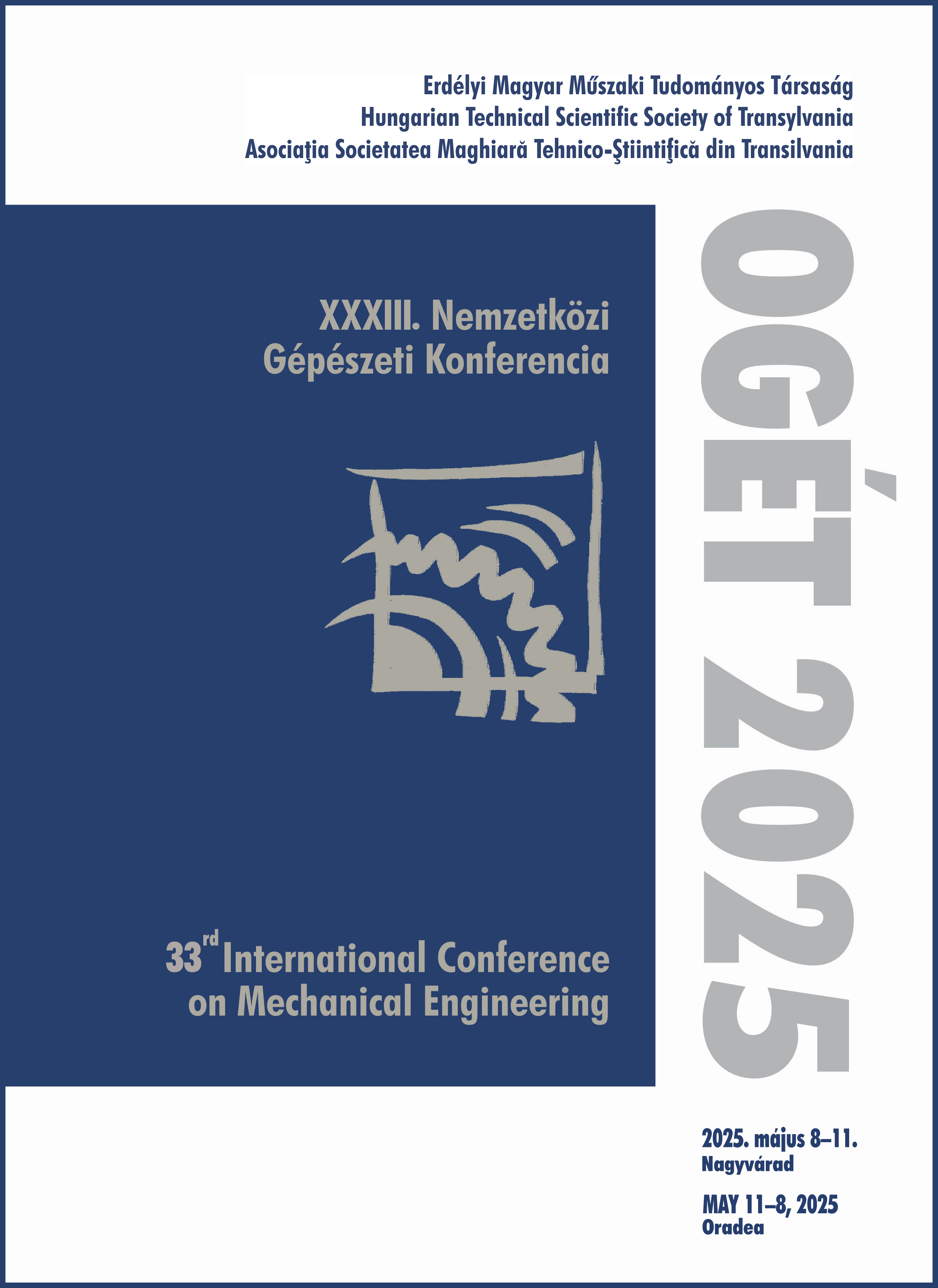Kísérlettervezés 3D nyomtatott alkatrészek szilárdságtani vizsgálatához
Design of experiments for the strength testing of 3D printed parts
Keywords:
additive manufacturing, design of experiments, machine learning, measurement data acquisition, mechanical strength, /, additív gyártás, kísérlettervezés, gépi tanulás, mérési adatgyűjtés, mechanikai szilárdságAbstract
The mechanical properties of FDM 3D printed parts are significantly influenced by manufacturing parameters, so proper Design of Experiments (DOE) is key to effective testing. The aim of this paper is to develop a DOE-based method for selecting relevant printing parameters, varying their values and collecting the related data for strength analysis.
The paper presents the selection of specimen materials and geometries that are adapted to the requirements of standard mechanical testing and the specificities of 3D printing. The printing parameters to be tested, which have a particular impact on the strength properties of the part, are defined.
The paper will also show the data requirements of different machine learning based methods and how they influence the experimental design process. Accordingly, requirements for data processing are taken into account in the design of the experiments. This approach will ensure that the data collected will provide an adequate basis for subsequent machine learning analyses, supporting the exploration of the relationships between printing parameters and mechanical properties.
Kivonat
Az FDM 3D nyomtatott alkatrészek mechanikai tulajdonságait jelentősen befolyásolják a gyártási paraméterek, így a megfelelő kísérlettervezés (Design of Experiments, DOE) kulcsfontosságú a hatékony vizsgálatokhoz. A cikk célja egy DOE-alapú módszer kidolgozása, amely lehetővé teszi a releváns nyomtatási paraméterek kiválasztását, értékük változtatását és az ehhez kapcsolódó adatgyűjtést szilárdságtani elemzések céljából.
A tanulmányban bemutatásra kerül a próbatestek anyagának és geometriájának kiválasztása, amely igazodik a szabványos mechanikai vizsgálatok követelményeihez és a 3D nyomtatás sajátosságaihoz. Meghatározásra kerülnek a vizsgált nyomtatási paraméterek, amelyek kiemelt hatással rendelkeznek a darab szilárdsági jellemzőire.
A tanulmányban emellett bemutatja, hogy a különböző gépi tanuláson alapuló módszerek milyen adatigénnyel rendelkeznek, és ezek hogyan befolyásolják a kísérlettervezési folyamatot. Ennek megfelelően a kísérleti terv kialakítása során figyelembe kerül a későbbi adatfeldolgozás szempontjai, optimalizálva az adatpontok számát és a változók kombinációját, az adatok dimenzióját. Ez a megközelítés biztosítja, hogy a gyűjtött adatok a későbbi gépi tanulási elemzésekhez megfelelő alapot nyújtsanak, támogatva a nyomtatási paraméterek és a mechanikai tulajdonságok közötti összefüggések feltárását.
References
M. Attaran, "The rise of 3-D printing: The advantages of additive manufacturing over traditional manufacturing," Business Horizons, vol. 60, no. 5, pp. 677-688, 2017, doi: 10.1016/j.bushor.2017.05.011.
D. Godec, J. Gonzalez-Gutierrez, A. Nordin, E. Pei, and J. Ureña, A Guide to Additive Manufacturing. Cham: Springer, Cham, 2022.
T. T. Wohlers, W. Associates, and T. Caffrey, Wohlers Report 2015: 3D Printing and Additive Manufacturing State of the Industry Annual Worldwide Progress Report. Wohlers Associates, 2015.
K. Wong, "K.V. Wong, A.Hernandez, “A Review of Additive Manufacturing,” ISRN Mechanical Engineering, Vol 2012 (2012), Article ID 208760, 10 pages," ISRN Mechanical Engineering, vol. 2012, 08/16 2012, doi: 10.5402/2012/208760.
Z.-X. Low, Y. T. Chua, B. M. Ray, D. Mattia, I. S. Metcalfe, and D. A. Patterson, "Perspective on 3D printing of separation membranes and comparison to related unconventional fabrication techniques," Journal of Membrane Science, vol. 523, pp. 596-613, 2017, doi: 10.1016/j.memsci.2016.10.006.
J. Y. Boey, C. K. Lee, and G. S. Tay, "Factors Affecting Mechanical Properties of Reinforced Bioplastics: A Review," Polymers (Basel), vol. 14, no. 18, Sep 7 2022, doi: 10.3390/polym14183737.
S. Liampas, N. Kladovasilakis, K. Tsongas, and E. M. Pechlivani, "Recent Advances in Additive Manufacturing of Fibre-Reinforced Materials: A Comprehensive Review," Applied Sciences, vol. 14, no. 22, doi: 10.3390/app142210100.
M. Santosh and S. Rajkumar, Effect of infill pattern and build orientation on mechanical properties of FDM printed parts: an experimental modal analysis approach. 2022.
C. Vălean, L. Marșavina, M. Mărghitaș, E. Linul, N. Razavi, and F. Berto, "Effect of manufacturing parameters on tensile properties of FDM printed specimens," Procedia Structural Integrity, vol. 26, pp. 313-320, 2020/01/01/ 2020, doi: https://doi.org/10.1016/j.prostr.2020.06.040.
R. Kristiawan, F. Imaduddin, D. Ariawan, U. Sabino, and Z. Arifin, "A review on the fused deposition modeling (FDM) 3D printing: Filament processing, materials, and printing parameters," Open Engineering, vol. 11, pp. 639-649, 04/01 2021, doi: 10.1515/eng-2021-0063.
M. Doshi, A. Mahale, S. Kumar Singh, and S. Deshmukh, "Printing parameters and materials affecting mechanical properties of FDM-3D printed Parts: Perspective and prospects," Materials Today: Proceedings, vol. 50, pp. 2269-2275, 2022, doi: 10.1016/j.matpr.2021.10.003.
B. Ádám, B. Polgár, "3D Nyomtatott Próbatestek Mechanikai Vizsgálata," Gradus, vol. 6, no. 1, p. 6, 2019.
T. Molnár, B. Zsótér "3D Nyomtatott Ipari Műanyagok Anyagvizsgálata A Műszaki Gyakorlatban," Gép, vol. 74, no. 2-3, pp. 35-45, 2023.
J. D. Kelleher, B. M. Namee, and A. D'Arcy, Fundamentals of Machine Learning for Predictive Data Analytics: Algorithms, Worked Examples, and Case Studies. The MIT Press, 2015.
O. O. Aremu, D. Hyland-Wood, and P. R. McAree, "A machine learning approach to circumventing the curse of dimensionality in discontinuous time series machine data," Reliability Engineering & System Safety, vol. 195, p. 106706, 2020/03/01/ 2020, doi: https://doi.org/10.1016/j.ress.2019.106706.
D. Rajput, W. J. Wang, and C. C. Chen, "Evaluation of a decided sample size in machine learning applications," BMC Bioinformatics, vol. 24, no. 1, p. 48, Feb 14 2023, doi: 10.1186/s12859-023-05156-9.
C. Catal and B. Diri, "Investigating the effect of dataset size, metrics sets, and feature selection techniques on software fault prediction problem," Information Sciences, vol. 179, no. 8, pp. 1040-1058, 2009, doi: 10.1016/j.ins.2008.12.001.
A. Vabalas, E. Gowen, E. Poliakoff, and A. J. Casson, "Machine learning algorithm validation with a
Y. Zhang and C. Ling, "A strategy to apply machine learning to small datasets in materials science," npj Computational Materials, vol. 4, no. 1, 2018, doi: 10.1038/s41524-018-0081-z.
B. Durakovic, "Design of experiments application, concepts, examples: State of the art," Periodicals of Engineering and Natural Sciences (PEN), vol. 5, no. 3, 2017, doi: 10.21533/pen.v5i3.145.


